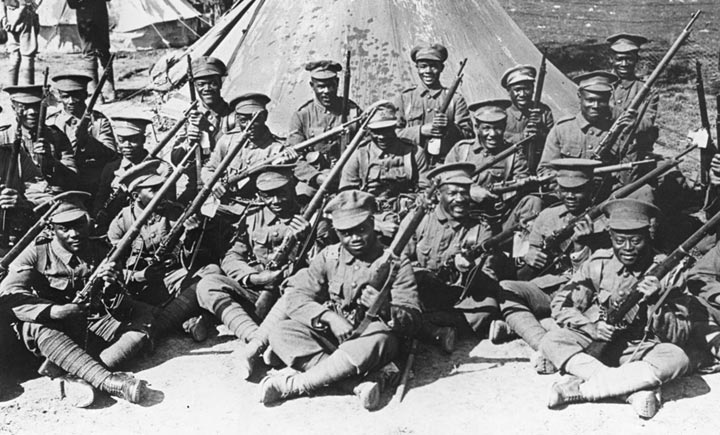MB 367/48915, Victoria League of New Zealand Records, Members of the British West Indies Regiment in camp on the Albert-Amiens Road during the Battle of the Somme, 1916. (Lt. Ernest Brooks; Albert-Amiens Road, Somme, France; September, 1916).

Members of the British West Indies Regiment

MB 367/48915, Victoria League of New Zealand Records, Members of the British West Indies Regiment in camp on the Albert-Amiens Road during the Battle of the Somme, 1916. (Lt. Ernest Brooks; Albert-Amiens Road, Somme, France; September, 1916).
National symbols, soldiers, and personalities were important in maintaining the enthusiasm of Britain’s dominions during the war. However, depictions of unfamiliar imperial soldiers, particularly from British imperial colonies such as India and the West Indies, were also powerful wartime symbols of the British Empire.
This photograph is another example of British official photographer Lt. Ernest Brooks’ more posed, formal photographs, of a group soldiers from the British West Indies Regiment, in camp on the Albert-Amiens Road, during the Somme Offensive of 1916. This image is notable as it reflects the manner in which imperial troops were presented in British propaganda. Images of British Imperial troops from both white settler dominions and imperial colonies such as India were numerous, as it was a strong British interest to present the strength, unity, size and diversity of its empire throughout the war, to reassure members of the empire, and to impress or intimidate neutral or enemy nations. However, the manner of depiction of peoples within the empire varied. Images of British soldiers interacting with troops from settler dominions such as New Zealand were common, and presented an image of the empire as a family of equals. This was important in maintaining dominion morale and enthusiasm for the war. Colonial troops, such as these British West Indian troops were rarely portrayed in the same inclusive manner. Instead, just as in this image, imperial troops were more commonly photographed separately, as their own distinct, yet important, component of the empire, as somewhat exotic imperial oddities. Despite this separation, it was still important to promote images of ‘imperial’ enthusiasm for the war, from regions such as the West Indies. These depictions of enthusiastic imperial involvement were not strictly fabrications, for instance the response from India alone garnered over 1,000,000 volunteers, while the West Indian Regiment fought in a number of campaigns, both in France, such as the Somme, and in sideshows in German colonies in Africa. It was therefore of great propaganda use for the British to portray this enthusiasm through images of enthusiastic, happy imperial troops, such as this image. These depictions helped the Britain’s colonies and dominions to conceptualise the war as a collective imperial struggle in which they had a vital role to play, instead of a strictly European war.